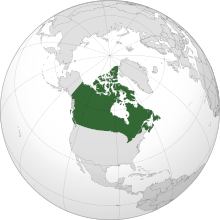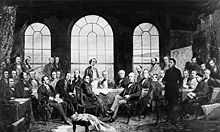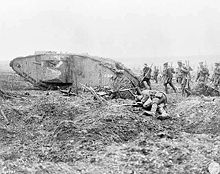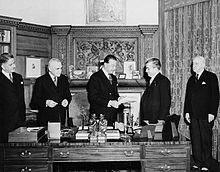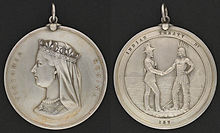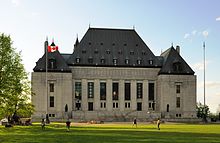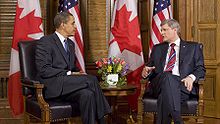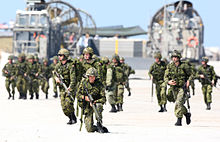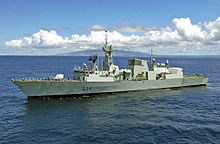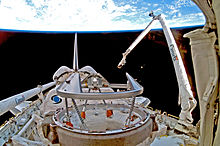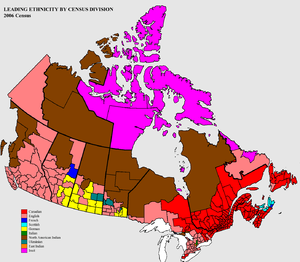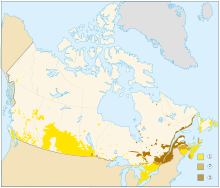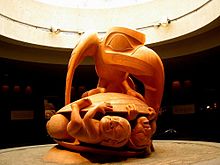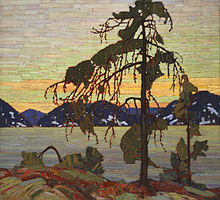
Canada
Background Information
SOS Children made this Wikipedia selection alongside other schools resources. SOS Children has looked after children in Africa for forty years. Can you help their work in Africa?
|
Canada
|
||||||
|---|---|---|---|---|---|---|
|
||||||
| Motto: " A Mari Usque Ad Mare" (Latin) "From Sea to Sea" |
||||||
| Anthem: O Canada Royal anthem: God Save the Queen |
||||||
|
|
||||||
| Capital | Ottawa 45°24′N 75°40′W |
|||||
| Largest city | Toronto | |||||
| Official languages |
|
|||||
| Recognised regional languages |
|
|||||
| Demonym | Canadian | |||||
| Government | Federal parliamentary democracy under constitutional monarchy |
|||||
| - | Monarch | Elizabeth II | ||||
| - | Governor General | David Johnston | ||||
| - | Prime Minister | Stephen Harper | ||||
| - | Chief Justice | Beverley McLachlin | ||||
| Legislature | Parliament | |||||
| - | Upper house | Senate | ||||
| - | Lower house | House of Commons | ||||
| Establishment from the United Kingdom | ||||||
| - | Constitution Act | July 1, 1867 | ||||
| - | Statute of Westminster | December 11, 1931 | ||||
| - | Canada Act | April 17, 1982 | ||||
| Area | ||||||
| - | Total | 9,984,670 km2 ( 2nd) 3,854,085 sq mi |
||||
| - | Water (%) | 8.92 (891,163 km2 / 344,080 mi2) | ||||
| Population | ||||||
| - | 2011 census | 33,476,688 ( 35th) | ||||
| - | Density | 3.41/km2 ( 228th) 8.3/sq mi |
||||
| GDP ( PPP) | 2012 estimate | |||||
| - | Total | $1.445 trillion ( 14th) | ||||
| - | Per capita | $41,506 ( 12th) | ||||
| GDP (nominal) | 2012 estimate | |||||
| - | Total | $1.770 trillion ( 10th) | ||||
| - | Per capita | $50,826 ( 9th) | ||||
| Gini (2005) | 32.1 medium |
|||||
| HDI (2013) | very high · 11th |
|||||
| Currency | Canadian dollar ($) ( CAD) |
|||||
| Time zone | ( UTC−3.5 to −8) | |||||
| - | Summer ( DST) | ( UTC−2.5 to −7) | ||||
| Date format |
|
|||||
| Drives on the | right | |||||
| Calling code | +1 | |||||
| ISO 3166 code | CA | |||||
| Internet TLD | .ca | |||||
Canada ( / ˈ k æ n ə d ə /) is a North American country consisting of ten provinces and three territories. Located in the northern part of the continent, it extends from the Atlantic to the Pacific and northward into the Arctic Ocean. Canada is the world's second-largest country by total area, and its common border with the United States is the world's longest land border.
The land that is now Canada has been inhabited for millennia by various Aboriginal peoples. Beginning in the late 15th century, British and French colonial expeditions explored, and later settled, the region's Atlantic coast. France ceded nearly all of its colonies in North America to the United Kingdom in 1763 after the French and Indian War, which was essentially the North American theatre of the Seven Years' War. In 1867, with the union of three British North American colonies through Confederation, Canada was formed as a federal dominion of four provinces. This began an accretion of provinces and territories and a process of increasing autonomy, culminating in the Canada Act 1982.
Canada is a federal state governed as a parliamentary democracy and a constitutional monarchy, with Queen Elizabeth II as its head of state. The country is officially bilingual and multicultural at the federal level, with a population of approximately 35 million as of 2013. Canada's advanced economy is one of the largest in the world, relying chiefly upon its abundant natural resources and well-developed trade networks, especially with the United States, with which it has had a long and complex relationship.
Canada is one of the world's most developed nations, with the ninth highest per capita income globally, and the sixth highest ranking in human development. Subsequently, Canada ranks among the highest in international measurements of education, government transparency, civil liberties, quality of life, and economic freedom. Canada is a recognized middle power and a member of many international institutions, including the G7, G8, G20, NATO, NAFTA, OECD, WTO, Commonwealth of Nations, Francophonie, OAS, APEC, and the United Nations.
Etymology
The name Canada comes from the St. Lawrence Iroquoian word kanata, meaning "village" or "settlement". In 1535, indigenous inhabitants of the present-day Quebec City region used the word to direct French explorer Jacques Cartier to the village of Stadacona. Cartier later used the word Canada to refer not only to that particular village, but the entire area subject to Donnacona (the chief at Stadacona); by 1545, European books and maps had begun referring to this region as Canada.
In the 17th and early 18th centuries, " Canada" referred to the part of New France that lay along the St. Lawrence River and the northern shores of the Great Lakes. The area was later split into two British colonies, Upper Canada and Lower Canada. They were reunified as the Province of Canada in 1841.
Upon Confederation in 1867, Canada was adopted as the legal name for the new country, and the word Dominion was conferred as the country's title. However, as Canada asserted its political autonomy from the United Kingdom, the federal government increasingly used simply Canada on state documents and treaties, a change that was reflected in the renaming of the national holiday from Dominion Day to Canada Day in 1982.
History
Aboriginal peoples
Archaeological studies and genetic analyses have indicated a human presence in the northern Yukon region from 24,500 BC, and in southern Ontario from 7500 BC. The Paleo-Indian archaeological sites at Old Crow Flats and Bluefish Caves are two of the oldest sites of human habitation in Canada. The characteristics of Canadian Aboriginal societies included permanent settlements, agriculture, complex societal hierarchies, and trading networks. Some of these cultures had collapsed by the time European explorers arrived in the late 15th and early 16th centuries, and have only been discovered through archaeological investigations.
The aboriginal population is estimated to have been between 200,000 and two million in the late 15th century, with a figure of 500,000 accepted by Canada's Royal Commission on Aboriginal Health. As a consequence of the European colonization, Canada's aboriginal peoples suffered from repeated outbreaks of newly introduced infectious diseases such as influenza, measles, and smallpox (to which they had no natural immunity), resulting in a forty- to eighty-percent population decrease in the centuries after the European arrival. Aboriginal peoples in present-day Canada include the First Nations, Inuit, and Métis. The Métis are a mixed-blood people who originated in the mid-17th century when First Nations and Inuit people married European settlers. In general, the Inuit had more limited interaction with European settlers during the colonization period.
European colonization
The first known attempt at European colonization began when Norsemen settled briefly at L'Anse aux Meadows in Newfoundland around 1000 AD. No further European exploration occurred until 1497, when Italian seafarer John Cabot explored Canada's Atlantic coast for England. Basque and Portuguese mariners established seasonal whaling and fishing outposts along the Atlantic coast in the early 16th century. In 1534, French explorer Jacques Cartier explored the St. Lawrence River, where on July 24 he planted a 10-metre (33 ft) cross bearing the words "Long Live the King of France", and took possession of the territory in the name of King Francis I of France.
In 1583, Sir Humphrey Gilbert claimed St. John's, Newfoundland, as the first North American English colony by the royal prerogative of Queen Elizabeth I. French explorer Samuel de Champlain arrived in 1603, and established the first permanent European settlements at Port Royal in 1605 and Quebec City in 1608. Among the French colonists of New France, Canadiens extensively settled the St. Lawrence River valley and Acadians settled the present-day Maritimes, while fur traders and Catholic missionaries explored the Great Lakes, Hudson Bay, and the Mississippi watershed to Louisiana. The Beaver Wars broke out in the mid-17th century over control of the North American fur trade.
The English established additional colonies in Cupids and Ferryland, Newfoundland, beginning in 1610. The Thirteen Colonies to the south were founded soon after. A series of four French and Indian Wars erupted between 1689 and 1763. Mainland Nova Scotia came under British rule with the 1713 Treaty of Utrecht; the Treaty of Paris (1763) ceded Canada and most of New France to Britain after the Seven Years' War.
The Royal Proclamation of 1763 created the Province of Quebec out of New France, and annexed Cape Breton Island to Nova Scotia. St. John's Island (now Prince Edward Island) became a separate colony in 1769. To avert conflict in Quebec, the British passed the Quebec Act of 1774, expanding Quebec's territory to the Great Lakes and Ohio Valley. It re-established the French language, Catholic faith, and French civil law there. This angered many residents of the Thirteen Colonies, fuelling anti-British sentiment in the years prior to the 1775 outbreak of the American Revolution.
The 1783 Treaty of Paris recognized American independence and ceded territories south of the Great Lakes to the United States. New Brunswick was split from Nova Scotia as part of a reorganization of Loyalist settlements in the Maritimes. To accommodate English-speaking Loyalists in Quebec, the Constitutional Act of 1791 divided the province into French-speaking Lower Canada (later Quebec) and English-speaking Upper Canada (later Ontario), granting each its own elected legislative assembly.
The Canadas were the main front in the War of 1812 between the United States and Britain. Following the war, large-scale immigration to Canada from Britain and Ireland began in 1815. Between 1825 and 1846, 626,628 European immigrants reportedly landed at Canadian ports. Between one-quarter and one-third of all Europeans who immigrated to Canada before 1891 died of infectious diseases.
The desire for responsible government resulted in the abortive Rebellions of 1837. The Durham Report subsequently recommended responsible government and the assimilation of French Canadians into English culture. The Act of Union 1840 merged the Canadas into a united Province of Canada. Responsible government was established for all British North American provinces by 1849. The signing of the Oregon Treaty by Britain and the United States in 1846 ended the Oregon boundary dispute, extending the border westward along the 49th parallel. This paved the way for British colonies on Vancouver Island (1849) and in British Columbia (1858).
Confederation and expansion
Following several constitutional conferences, the 1867 Constitution Act officially proclaimed Canadian Confederation on July 1, 1867, initially with four provinces – Ontario, Quebec, Nova Scotia, and New Brunswick. Canada assumed control of Rupert's Land and the North-Western Territory to form the Northwest Territories, where the Métis' grievances ignited the Red River Rebellion and the creation of the province of Manitoba in July 1870. British Columbia and Vancouver Island (which had been united in 1866) joined the Confederation in 1871, while Prince Edward Island joined in 1873. Prime Minister John A. Macdonald and his Conservative government established a National Policy of tariffs to protect the nascent Canadian manufacturing industries.
To open the West, the government sponsored the construction of three transcontinental railways (including the Canadian Pacific Railway), opened the prairies to settlement with the Dominion Lands Act, and established the North-West Mounted Police to assert its authority over this territory. In 1898, during the Klondike Gold Rush in the Northwest Territories, the Canadian government created the Yukon Territory. Under the Liberal Prime Minister Wilfrid Laurier, continental European immigrants settled the prairies, and Alberta and Saskatchewan became provinces in 1905.
Early 20th century
Because Britain still maintained control of Canada's foreign affairs under the Confederation Act, its declaration of war in 1914 automatically brought Canada into World War I. Volunteers sent to the Western Front later became part of the Canadian Corps. The Corps played a substantial role in the Battle of Vimy Ridge and other major engagements of the war. Out of approximately 625,000 Canadians who served in World War I, around 60,000 were killed and another 173,000 were wounded. The Conscription Crisis of 1917 erupted when conservative Prime Minister Robert Borden brought in compulsory military service over the objections of French-speaking Quebecers. In 1919, Canada joined the League of Nations independently of Britain, and the 1931 Statute of Westminster affirmed Canada's independence.
The great depression in Canada during the early 1930s saw an economic downturn, leading to hardship across the country. In response to the downturn, the Co-operative Commonwealth Federation (CCF) in Saskatchewan introduced many elements of a welfare state (as pioneered by Tommy Douglas) in the 1940s and 1950s. Canada declared war on Germany independently during World War II under Liberal Prime Minister William Lyon Mackenzie King, three days after Britain. The first Canadian Army units arrived in Britain in December 1939.
Canadian troops played important roles in many key battles of the war, including the failed 1942 Dieppe Raid, the Allied invasion of Italy, the Normandy landings, the Battle of Normandy, and the Battle of the Scheldt in 1944. Canada provided asylum for the Dutch monarchy while that country was occupied, and is credited by the Netherlands for major contributions to its liberation from Nazi Germany. The Canadian economy boomed during the war as its industries manufactured military materiel for Canada, Britain, China, and the Soviet Union. Despite another Conscription Crisis in Quebec in 1944, Canada finished the war with a large army and strong economy.
Modern times
The Dominion of Newfoundland (now Newfoundland and Labrador) was unified with Canada in 1949. Canada's post-war economic growth, combined with the policies of successive Liberal governments, led to the emergence of a new Canadian identity, marked by the adoption of the current Maple Leaf Flag in 1965, the implementation of official bilingualism (English and French) in 1969, and the institution of official multiculturalism in 1971. Socially democratic programs were also instituted, such as Medicare, the Canada Pension Plan, and Canada Student Loans, though provincial governments, particularly Quebec and Alberta, opposed many of these as incursions into their jurisdictions. Finally, another series of constitutional conferences resulted in the 1982 patriation of Canada's constitution from the United Kingdom, concurrent with the creation of the Canadian Charter of Rights and Freedoms. In 1999, Nunavut became Canada's third territory after a series of negotiations with the federal government.
At the same time, Quebec underwent profound social and economic changes through the Quiet Revolution of the 1960s, giving birth to a modern nationalist movement. The radical Front de libération du Québec (FLQ) ignited the October Crisis with a series of bombings and kidnappings in 1970, and the sovereignist Parti Québécois was elected in 1976, organizing an unsuccessful referendum on sovereignty-association in 1980. Attempts to accommodate Quebec nationalism constitutionally through the Meech Lake Accord failed in 1990. This led to the formation of the Bloc Québécois in Quebec and the invigoration of the Reform Party of Canada in the West. A second referendum followed in 1995, in which sovereignty was rejected by a slimmer margin of just 50.6 to 49.4 percent. In 1997, the Supreme Court ruled that unilateral secession by a province would be unconstitutional, and the Clarity Act was passed by parliament, outlining the terms of a negotiated departure from Confederation.
In addition to the issues of Quebec sovereignty, a number of crises shook Canadian society in the late 1980s and early 1990s. These included the explosion of Air India Flight 182 in 1985, the largest mass murder in Canadian history; the École Polytechnique massacre in 1989, a university shooting targeting female students; and the Oka Crisis of 1990, the first of a number of violent confrontations between the government and Aboriginal groups. Canada also joined the Gulf War in 1990 as part of a US-led coalition force, and was active in several peacekeeping missions in the 1990s, including the UNPROFOR mission in the former Yugoslavia. Canada sent troops to Afghanistan in 2001, but declined to send forces to Iraq when the US invaded in 2003. In 2009, Canada's economy suffered in the worldwide Great Recession, but has since rebounded modestly. In 2011, Canadian forces participated in the NATO-led intervention into the Libyan civil war.
Geography
Canada occupies a major northern portion of North America, sharing land borders with the contiguous United States to the south and the US state of Alaska to the northwest. Canada stretches from the Atlantic Ocean in the east to the Pacific Ocean in the west; to the north lies the Arctic Ocean. Greenland is to the northeast, while Saint Pierre and Miquelon is south of Newfoundland. By total area (including its waters), Canada is the second-largest country in the world, after Russia. By land area alone, Canada ranks fourth. The country lies between latitudes 41° and 84°N, and longitudes 52° and 141°W.
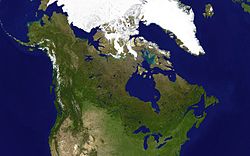
Since 1925, Canada has claimed the portion of the Arctic between 60° and 141°W longitude, but this claim is not universally recognized. Canada is home to the world's northernmost settlement, Canadian Forces Station Alert, on the northern tip of Ellesmere Island – latitude 82.5°N – which lies 817 kilometres (508 mi) from the North Pole. Much of the Canadian Arctic is covered by ice and permafrost. Canada has the longest coastline in the world, with a total length of 202,080 kilometres (125,570 mi); additionally, its border with the United States is the world's longest land border, stretching 8,891 kilometres (5,525 mi).
Since the end of the last glacial period, Canada has consisted of eight distinct forest regions, including extensive boreal forest on the Canadian Shield. Canada has around 31,700 large lakes, more than any other country, containing much of the world's fresh water. There are also fresh-water glaciers in the Canadian Rockies and the Coast Mountains. Canada is geologically active, having many earthquakes and potentially active volcanoes, notably Mount Meager, Mount Garibaldi, Mount Cayley, and the Mount Edziza volcanic complex. The volcanic eruption of the Tseax Cone in 1775 was among Canada's worst natural disasters, killing 2,000 Nisga'a people and destroying their village in the Nass River valley of northern British Columbia. The eruption produced a 22.5-kilometre (14.0 mi) lava flow, and, according to Nisga'a legend, blocked the flow of the Nass River.
Canada's population density, at 3.3 inhabitants per square kilometre (8.5 /sq mi), is among the lowest in the world. The most densely populated part of the country is the Quebec City – Windsor Corridor, situated in Southern Quebec and Southern Ontario along the Great Lakes and the St. Lawrence River.
Average winter and summer high temperatures across Canada vary from region to region. Winters can be harsh in many parts of the country, particularly in the interior and Prairie provinces, which experience a continental climate, where daily average temperatures are near −15 °C (5 ° F), but can drop below −40 °C (−40 °F) with severe wind chills. In noncoastal regions, snow can cover the ground for almost six months of the year, while in parts of the north snow can persist year-round. Coastal British Columbia has a temperate climate, with a mild and rainy winter. On the east and west coasts, average high temperatures are generally in the low 20s °C (70s °F), while between the coasts, the average summer high temperature ranges from 25 to 30 °C (77 to 86 °F), with temperatures in some interior locations occasionally exceeding 40 °C (104 °F).
Government and politics
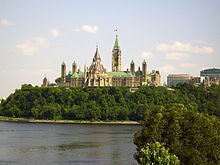
Canada has a parliamentary system within the context of a constitutional monarchy, the monarchy of Canada being the foundation of the executive, legislative, and judicial branches. The sovereign is Queen Elizabeth II, who also serves as head of state of 15 other Commonwealth countries and each of Canada's ten provinces. As such, the Queen's representative, the Governor General of Canada (at present David Lloyd Johnston), carries out most of the federal royal duties in Canada.
The direct participation of the royal and viceroyal figures in areas of governance is limited. In practice, their use of the executive powers is directed by the Cabinet, a committee of ministers of the Crown responsible to the elected House of Commons and chosen and headed by the Prime Minister of Canada (at present Stephen Harper), the head of government. The governor general or monarch may, though, in certain crisis situations exercise their power without ministerial advice. To ensure the stability of government, the governor general will usually appoint as prime minister the person who is the current leader of the political party that can obtain the confidence of a plurality in the House of Commons. The Prime Minister's Office (PMO) is thus one of the most powerful institutions in government, initiating most legislation for parliamentary approval and selecting for appointment by the Crown, besides the aforementioned, the governor general, lieutenant governors, senators, federal court judges, and heads of Crown corporations and government agencies. The leader of the party with the second-most seats usually becomes the Leader of Her Majesty's Loyal Opposition (presently Thomas Mulcair) and is part of an adversarial parliamentary system intended to keep the government in check.
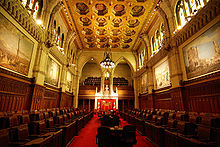
Each of the 308 Members of Parliament in the House of Commons is elected by simple plurality in an electoral district or riding. General elections must be called by the governor general, either on the advice of the prime minister, within four years of the previous election, or if the government loses a confidence vote in the House. The 105 members of the Senate, whose seats are apportioned on a regional basis, serve until age 75. Five parties had representatives elected to the federal parliament in the 2011 elections: the Conservative Party of Canada (governing party), the New Democratic Party (the Official Opposition), the Liberal Party of Canada, the Bloc Québécois, and the Green Party of Canada. The list of historical parties with elected representation is substantial.
Canada's federal structure divides government responsibilities between the federal government and the ten provinces. Provincial legislatures are unicameral and operate in parliamentary fashion similar to the House of Commons. Canada's three territories also have legislatures, but these are not sovereign and have fewer constitutional responsibilities than the provinces. The territorial legislatures also differ structurally from their provincial counterparts.
Law
The Constitution of Canada is the supreme law of the country, and consists of written text and unwritten conventions. The Constitution Act, 1867 (known as the British North America Act prior to 1982), affirmed governance based on parliamentary precedent and divided powers between the federal and provincial governments. The Statute of Westminster 1931 granted full autonomy and the Constitution Act, 1982, ended all legislative ties to the UK, as well as adding a constitutional amending formula and the Canadian Charter of Rights and Freedoms. The Charter guarantees basic rights and freedoms that usually cannot be overridden by any government—though a notwithstanding clause allows the federal parliament and provincial legislatures to override certain sections of the Charter for a period of five years.
Although not without conflict, European Canadians' early interactions with First Nations and Inuit populations were relatively peaceful. The Crown and Aboriginal peoples began interactions during the European colonialization period. The Indian Act, various treaties and case laws were established to mediate relations between Europeans and native peoples. Most notably, a series of eleven treaties known as the Numbered Treaties were signed between Aboriginals in Canada and the reigning Monarch of Canada between 1871 and 1921. These treaties are agreements with the Canadian Crown-in-Council, administered by Canadian Aboriginal law, and overseen by the Minister of Aboriginal Affairs and Northern Development. The role of the treaties and the rights they support were reaffirmed by Section Thirty-five of the Constitution Act, 1982. These rights may include provision of services such as health care, and exemption from taxation. The legal and policy framework within which Canada and First Nations operate was further formalized in 2005, through the First Nations–Federal Crown Political Accord.
Canada's judiciary plays an important role in interpreting laws and has the power to strike down Acts of Parliament that violate the constitution. The Supreme Court of Canada is the highest court and final arbiter and has been led since 2000 by the Chief Justice Beverley McLachlin (the first female Chief Justice). Its nine members are appointed by the governor general on the advice of the prime minister and minister of justice. All judges at the superior and appellate levels are appointed after consultation with nongovernmental legal bodies. The federal Cabinet also appoints justices to superior courts in the provincial and territorial jurisdictions.
Common law prevails everywhere except in Quebec, where civil law predominates. Criminal law is solely a federal responsibility and is uniform throughout Canada. Law enforcement, including criminal courts, is officially a provincial responsibility, conducted by provincial and municipal police forces. However, in most rural areas and some urban areas, policing responsibilities are contracted to the federal Royal Canadian Mounted Police.
Foreign relations and military
Canada currently employs a professional, volunteer military force of 65,000 regular personnel and approximately 53,000 reserve personnel, including supplementary reserves and civilian employees. The unified Canadian Forces (CF) comprise the Canadian Army, Royal Canadian Navy, and Royal Canadian Air Force. In 2011, Canada's military expenditure totalled approximately C$24.5 billion.
Canada and the United States share the world's longest undefended border, co-operate on military campaigns and exercises, and are each other's largest trading partner. Canada nevertheless has an independent foreign policy, most notably maintaining full relations with Cuba and declining to officially participate in the 2003 invasion of Iraq. Canada also maintains historic ties to the United Kingdom and France and to other former British and French colonies through Canada's membership in the Commonwealth of Nations and the Francophonie. Canada is noted for having a positive relationship with the Netherlands, owing, in part, to its contribution to the Dutch liberation during World War II.
Canada's strong attachment to the British Empire and Commonwealth led to major participation in British military efforts in the Second Boer War, World War I and World War II. Since then, Canada has been an advocate for multilateralism, making efforts to resolve global issues in collaboration with other nations. Canada was a founding member of the United Nations in 1945 and of NATO in 1949. During the Cold War, Canada was a major contributor to UN forces in the Korean War and founded the North American Aerospace Defense Command (NORAD) in cooperation with the United States to defend against potential aerial attacks from the Soviet Union.
During the Suez Crisis of 1956, future Prime Minister Lester B. Pearson eased tensions by proposing the inception of the United Nations Peacekeeping Force, for which he was awarded the 1957 Nobel Peace Prize. As this was the first UN peacekeeping mission, Pearson is often credited as the inventor of the concept. Canada has since served in 50 peacekeeping missions, including every UN peacekeeping effort until 1989, and has since maintained forces in international missions in Rwanda, the former Yugoslavia, and elsewhere; Canada has sometimes faced controversy over its involvement in foreign countries, notably in the 1993 Somalia Affair.
Canada joined the Organization of American States (OAS) in 1990 and hosted the OAS General Assembly in Windsor, Ontario, in June 2000 and the third Summit of the Americas in Quebec City in April 2001. Canada seeks to expand its ties to Pacific Rim economies through membership in the Asia-Pacific Economic Cooperation forum (APEC).
In 2001, Canada deployed troops to Afghanistan as part of the US stabilization force and the UN-authorized, NATO-led International Security Assistance Force. Starting in July 2011, Canada began withdrawing its troops from Afghanistan. In all, Canada lost 158 soldiers, one diplomat, two aid workers, and one journalist during the mission, which cost approximately C$11.3 billion.
In February 2007, Canada, Italy, the United Kingdom, Norway, and Russia announced their joint commitment to a $1.5-billion project to help develop vaccines for developing nations, and called on other countries to join them. In August 2007, Canada's territorial claims in the Arctic were challenged after a Russian underwater expedition to the North Pole; Canada has considered that area to be sovereign territory since 1925. Between March and October 2011, Canadian forces participated in a UN-mandated NATO intervention into the 2011 Libyan civil war.
Provinces and territories
Canada is a federation composed of ten provinces and three territories. In turn, these may be grouped into four main regions: Western Canada, Central Canada, Atlantic Canada, and Northern Canada ("Eastern Canada" refers to Central Canada and Atlantic Canada together). Provinces have more autonomy than territories, having responsibility for social programs such as health care, education, and welfare. Together, the provinces collect more revenue than the federal government, an almost unique structure among federations in the world. Using its spending powers, the federal government can initiate national policies in provincial areas, such as the Canada Health Act; the provinces can opt out of these, but rarely do so in practice. Equalization payments are made by the federal government to ensure that reasonably uniform standards of services and taxation are kept between the richer and poorer provinces.
Economy
Canada is the world's eleventh-largest economy, with a 2012 nominal GDP of approximately US$1.77 trillion. It is a member of the Organisation for Economic Co-operation and Development (OECD) and the G8, and is one of the world's top ten trading nations, with a highly globalized economy. Canada is a mixed economy, ranking above the US and most western European nations on the Heritage Foundation's index of economic freedom, and experiencing a relatively low level of income disparity. In 2008, Canada's imported goods were worth over $442.9 billion, of which $280.8 billion originated from the United States, $11.7 billion from Japan, and $11.3 billion from the United Kingdom. The country's 2009 trade deficit totaled C$4.8 billion, compared with a C$46.9 billion surplus in 2008.
Since the early 20th century, the growth of Canada's manufacturing, mining, and service sectors has transformed the nation from a largely rural economy to an urbanized, industrial one. Like many other First World nations, the Canadian economy is dominated by the service industry, which employs about three-quarters of the country's workforce. However, Canada is unusual among developed countries in the importance of its primary sector, in which the logging and petroleum industries are two of the most prominent components.
Canada is one of the few developed nations that are net exporters of energy. Atlantic Canada possesses vast offshore deposits of natural gas, and Alberta also hosts large oil and gas resources. The immense Athabasca oil sands give Canada the world's second-largest proven oil reserves, after Saudi Arabia. Canada is additionally one of the world's largest suppliers of agricultural products; the Canadian Prairies are one of the most important global producers of wheat, canola, and other grains. Canada is a major producer of zinc and uranium, and is a leading exporter of many other minerals, such as gold, nickel, aluminium, and lead. Many towns in northern Canada, where agriculture is difficult, are sustainable because of nearby mines or sources of timber. Canada also has a sizable manufacturing sector centred in southern Ontario and Quebec, with automobiles and aeronautics representing particularly important industries.
Canada's economic integration with the United States has increased significantly since World War II. The Automotive Products Trade Agreement of 1965 opened Canada's borders to trade in the automobile manufacturing industry. In the 1970s, concerns over energy self-sufficiency and foreign ownership in the manufacturing sectors prompted Prime Minister Pierre Trudeau's Liberal government to enact the National Energy Program (NEP) and the Foreign Investment Review Agency (FIRA). In the 1980s, Prime Minister Brian Mulroney's Progressive Conservatives abolished the NEP and changed the name of FIRA to " Investment Canada", in order to encourage foreign investment. The Canada – United States Free Trade Agreement (FTA) of 1988 eliminated tariffs between the two countries, while the North American Free Trade Agreement (NAFTA) expanded the free-trade zone to include Mexico in 1994. In the mid-1990s, Jean Chrétien's Liberal government began to post annual budgetary surpluses, and steadily paid down the national debt.
The global financial crisis of 2008 caused a major recession, which led to a significant rise in unemployment in Canada. By October 2009, Canada's national unemployment rate had reached 8.6 percent, with provincial unemployment rates varying from a low of 5.8 percent in Manitoba to a high of 17 percent in Newfoundland and Labrador. Between October 2008 and October 2010, the Canadian labour market lost 162,000 full-time jobs and a total of 224,000 permanent jobs. Canada's federal debt was estimated to total $566.7 billion for the fiscal year 2010–11, up from $463.7 billion in 2008–09. In addition, Canada's net foreign debt rose by $41 billion to $194 billion in the first quarter of 2010. However, Canada's regulated banking sector (comparatively conservative among G8 nations), the federal government's pre-crisis budgetary surpluses, and its long-term policies of lowering the national debt, resulted in a less severe recession compared to other G8 nations. As of late 2012, the majority of the Canadian economy has stabilized, although the country remains troubled by slow growth, sensitivity to the Eurozone crisis and higher-than-normal unemployment rates. The federal government and many Canadian industries have also started to expand trade with emerging Asian markets, in an attempt to diversify exports; in 2011, Asia was Canada's second-largest export market, after the United States. Widely debated oil pipeline proposals, in particular, are hoped to increase exports of Canadian oil reserves to China.
Science and technology
In 2011, Canada spent approximately C$29.9 billion on domestic research and development. As of 2012, the country has produced fourteen Nobel laureates in physics, chemistry and medicine, and was ranked fourth worldwide for scientific research quality in a major 2012 survey of international scientists. It is additionally home to a number of global technology firms. Canada ranks seventeenth in the world for Internet users as a proportion of the population, with over 28.4 million users, equivalent to around 83 percent of its total 2012 population.
The Canadian Space Agency operates a highly active space program, conducting deep-space, planetary, and aviation research, and developing rockets and satellites. Canada was the third country to launch a satellite into space after the USSR and the United States, with the 1962 Alouette 1 launch. In 1984, Marc Garneau became Canada's first astronaut. As of 2012, nine Canadians have flown into space, over the course of fifteen manned missions.
Canada is a participant in the International Space Station (ISS), and is a pioneer in space robotics, having constructed the Canadarm, Canadarm2 and Dextre robotic manipulators for the ISS and NASA's Space Shuttle. Since the 1960s, Canada's aerospace industry has designed and built numerous marques of satellite, including Radarsat-1 and 2, ISIS and MOST. Canada has also produced a successful and widely used sounding rocket, the Black Brant; over 1,000 Black Brants have been launched since the rocket's introduction in 1961.
Demographics
The 2011 Canadian census counted a total population of 33,476,688, an increase of around 5.9 percent over the 2006 figure. Between 1990 and 2008, the population increased by 5.6 million, equivalent to 20.4 percent overall growth. The main drivers of population growth are immigration and, to a lesser extent, natural growth. About four-fifths of the population lives within 150 kilometres (93 mi) of the United States border. Approximately 80 percent of Canadians live in urban areas concentrated in the Quebec City–Windsor Corridor, the British Columbia Lower Mainland, and the Calgary–Edmonton Corridor in Alberta. Canada spans latitudinally from the 83rd parallel north to the 41st parallel north, and approximately 95% of the population is found below the 55th parallel north. In common with many other developed countries, Canada is experiencing a demographic shift towards an older population, with more retirees and fewer people of working age. In 2006, the average age was 39.5 years; by 2011, it had risen to approximately 39.9 years. As of 2013, the average life expectancy for Canadians is 81 years.
According to the 2006 census, the country's largest self-reported ethnic origin is Canadian (accounting for 32% of the population), followed by English (21%), French (15.8%), Scottish (15.1%), Irish (13.9%), German (10.2%), Italian (4.6%), Chinese (4.3%), First Nations (4.0%), Ukrainian (3.9%), and Dutch (3.3%). There are 600 recognized First Nations governments or bands, encompassing a total of 1,172,790 people.
Canada's aboriginal population is growing at almost twice the national rate, and four percent of Canada's population claimed aboriginal identity in 2006. Another 16.2 percent of the population belonged to a non-aboriginal visible minority. The largest visible minority groups are South Asian (4.0%), Chinese (3.9%) and Black (2.5%). Between 2001 and 2006, the visible minority population rose by 27.2 percent. In 1961, less than two percent of Canada's population (about 300,000 people) could be classified as belonging to a visible minority group, and less than one percent as aboriginal. By 2007, almost one in five (19.8%) were foreign-born, with nearly 60 percent of new immigrants coming from Asia (including the Middle East). The leading sources of immigrants to Canada were China, the Philippines and India. According to Statistics Canada, visible minority groups could account for a third of the Canadian population by 2031.
Canada has one of the highest per-capita immigration rates in the world, driven by economic policy and family reunification. In 2010, a record 280,636 people immigrated to Canada. The Canadian government anticipated between 240,000 and 265,000 new permanent residents in 2012, a similar number of immigrants as in recent years. New immigrants settle mostly in major urban areas like Toronto and Vancouver. Canada also accepts large numbers of refugees, accounting for over 10 percent of annual global refugee resettlements.
Canada is religiously diverse, encompassing a wide range of beliefs and customs. According to the 2001 census, 77.1 percent of Canadians identify as Christian; of this, Catholics make up the largest group, accounting for 43.6 percent of the population. The largest Protestant denomination is the United Church of Canada (accounting for 9.5% of Canadians), followed by Anglicans (6.8%), Baptists (2.4%), Lutherans (2%), and other Christian denominations (4.4%). About 16.5 percent declare no religious affiliation, and the remaining 6.3 percent are affiliated with non-Christian religions, the largest of which are Islam (2.0%) and Judaism (1.1%).
Canadian provinces and territories are responsible for education. The mandatory school age ranges between 5–7 to 16–18 years, contributing to an adult literacy rate of 99 percent. As of 2011, 88 percent of adults aged 25 to 64 have earned the equivalent of a high-school degree, compared to an OECD average of 74 percent. In 2002, 43 percent of Canadians aged 25 to 64 possessed a post-secondary education; for those aged 25 to 34, the rate of post-secondary education reached 51 percent. The Programme for International Student Assessment indicates that Canadian students perform well above the OECD average, particularly in mathematics, science, and reading.
| Largest metropolitan areas in Canada by population ( 2011 Census) | ||||||||
|---|---|---|---|---|---|---|---|---|
| Name | Province | Population | Name | Province | Population | |||
| Toronto | Ontario | 5,583,064 | London | Ontario | 474,786 | |||
| Montreal | Quebec | 3,824,221 | St. Catharines– Niagara | Ontario | 392,184 | |||
| Vancouver | British Columbia | 2,313,328 | Halifax | Nova Scotia | 390,328 | |||
| Ottawa– Gatineau | Ontario– Quebec | 1,236,324 | Oshawa | Ontario | 356,177 | |||
| Calgary | Alberta | 1,214,839 | Victoria | British Columbia | 344,615 | |||
| Edmonton | Alberta | 1,159,869 | Windsor | Ontario | 319,246 | |||
| Quebec | Quebec | 765,706 | Saskatoon | Saskatchewan | 260,600 | |||
| Winnipeg | Manitoba | 730,018 | Regina | Saskatchewan | 210,556 | |||
| Hamilton | Ontario | 721,053 | Sherbrooke | Quebec | 201,890 | |||
| Kitchener– Cambridge– Waterloo | Ontario | 477,160 | St. John's | Newfoundland and Labrador | 196,966 | |||
Language
Canada's two official languages are Canadian English and Canadian French. Official bilingualism is defined in the Canadian Charter of Rights and Freedoms, the Official Languages Act, and Official Language Regulations; it is applied by the Commissioner of Official Languages. English and French have equal status in federal courts, Parliament, and in all federal institutions. Citizens have the right, where there is sufficient demand, to receive federal government services in either English or French, and official-language minorities are guaranteed their own schools in all provinces and territories.
English and French are the first languages of 59.7 and 23.2 percent of the population respectively. Approximately 98 percent of Canadians speak English or French: 57.8 percent speak English only, 22.1 percent speak French only, and 17.4 percent speak both. The English and French official-language communities, defined by the first official language spoken, constitute 73.0 and 23.6 percent of the population respectively.
The 1977 Charter of the French Language established French as the official language of Quebec. Although more than 85 percent of French-speaking Canadians live in Quebec, there are substantial Francophone populations in Ontario, Alberta, and southern Manitoba; Ontario has the largest French-speaking population outside Quebec. New Brunswick, the only officially bilingual province, has a French-speaking Acadian minority constituting 33 percent of the population. There are also clusters of Acadians in southwestern Nova Scotia, on Cape Breton Island, and through central and western Prince Edward Island.
Other provinces have no official languages as such, but French is used as a language of instruction, in courts, and for other government services, in addition to English. Manitoba, Ontario, and Quebec allow for both English and French to be spoken in the provincial legislatures, and laws are enacted in both languages. In Ontario, French has some legal status, but is not fully co-official. There are 11 Aboriginal language groups, composed of more than 65 distinct dialects. Of these, only the Cree, Inuktitut and Ojibway languages have a large enough population of fluent speakers to be considered viable to survive in the long term. Several aboriginal languages have official status in the Northwest Territories. Inuktitut is the majority language in Nunavut, and is one of three official languages in the territory.
In 2011, nearly 6.8 million Canadians listed a non-official language as their mother tongue. Some of the most common non-official first languages include Chinese (mainly Cantonese; 1,012,065 first-language speakers), Italian (455,040), German (450,570), Punjabi (367,505) and Spanish (345,345).
Culture
Canada's culture draws influences from its broad range of constituent nationalities, and policies that promote multiculturalism are constitutionally protected. In Quebec, cultural identity is strong, and many French-speaking commentators speak of a culture of Quebec that is distinct from English Canadian culture. However, as a whole, Canada is in theory a cultural mosaic – a collection of several regional, aboriginal, and ethnic subcultures. Government policies such as publicly funded health care, higher taxation to redistribute wealth, the outlawing of capital punishment, strong efforts to eliminate poverty, strict gun control, and the legalization of same-sex marriage are further social indicators of Canada's political and cultural values.
Historically, Canada has been influenced by British, French, and aboriginal cultures and traditions. Through their language, art and music, aboriginal peoples continue to influence the Canadian identity. Many Canadians value multiculturalism and see Canada as being inherently multicultural. American media and entertainment are popular, if not dominant, in English Canada; conversely, many Canadian cultural products and entertainers are successful in the United States and worldwide. The preservation of a distinctly Canadian culture is supported by federal government programs, laws, and institutions such as the Canadian Broadcasting Corporation (CBC), the National Film Board of Canada (NFB), and the Canadian Radio-television and Telecommunications Commission (CRTC).
Canadian visual art has been dominated by figures such as Tom Thomson – the country's most famous painter – and by the Group of Seven. Thomson's career painting Canadian landscapes spanned a decade up to his death in 1917 at age 39. The Group were painters with a nationalistic and idealistic focus, who first exhibited their distinctive works in May 1920. Though referred to as having seven members, five artists – Lawren Harris, A. Y. Jackson, Arthur Lismer, J. E. H. MacDonald, and Frederick Varley – were responsible for articulating the Group's ideas. They were joined briefly by Frank Johnston, and by commercial artist Franklin Carmichael. A. J. Casson became part of the Group in 1926. Associated with the Group was another prominent Canadian artist, Emily Carr, known for her landscapes and portrayals of the indigenous peoples of the Pacific Northwest Coast. Since the 1950s, works of Inuit art have been given as gifts to foreign dignitaries by the Canadian government.
The Canadian music industry has produced internationally renowned composers, musicians and ensembles. Music broadcasting in the country is regulated by the Canadian Radio-television and Telecommunications Commission (CRTC). The Canadian Academy of Recording Arts and Sciences presents Canada's music industry awards, the Juno Awards, which were first awarded in 1970. The national anthem of Canada, O Canada, was originally commissioned by the Lieutenant Governor of Quebec, the Honourable Théodore Robitaille, for the 1880 St. Jean-Baptiste Day ceremony, and was officially adopted in 1980. Calixa Lavallée wrote the music, which was a setting of a patriotic poem composed by the poet and judge Sir Adolphe-Basile Routhier. The text was originally only in French, before it was translated to English in 1906.

The roots of organized sports in Canada date back to the 1770s. Canada's official national sports are ice hockey and lacrosse. Seven of Canada's eight largest metropolitan areas – Toronto, Montreal, Vancouver, Ottawa, Calgary, Edmonton and Winnipeg – have franchises in the National Hockey League (NHL). Other popular spectator sports in Canada include curling and football; the latter is played professionally in the Canadian Football League (CFL). Golf, baseball, skiing, soccer, cricket, volleyball, rugby league and basketball are widely played at youth and amateur levels, but professional leagues and franchises are not widespread. Canada has participated in almost every Olympic Games since its Olympic debut in 1900, and has hosted several high-profile international sporting events, including the 1976 Summer Olympics in Montreal, the 1988 Winter Olympics in Calgary, the 1994 Basketball World Championship and the 2007 FIFA U-20 World Cup. Canada was the host nation for the 2010 Winter Olympics in Vancouver and Whistler, British Columbia.
Canada's national symbols are influenced by natural, historical, and Aboriginal sources. The use of the maple leaf as a Canadian symbol dates to the early 18th century. The maple leaf is depicted on Canada's current and previous flags, on the penny, and on the Arms of Canada. Other prominent symbols include the beaver, Canada Goose, Common Loon, the Crown, the Royal Canadian Mounted Police, and more recently, the totem pole and Inuksuk.


